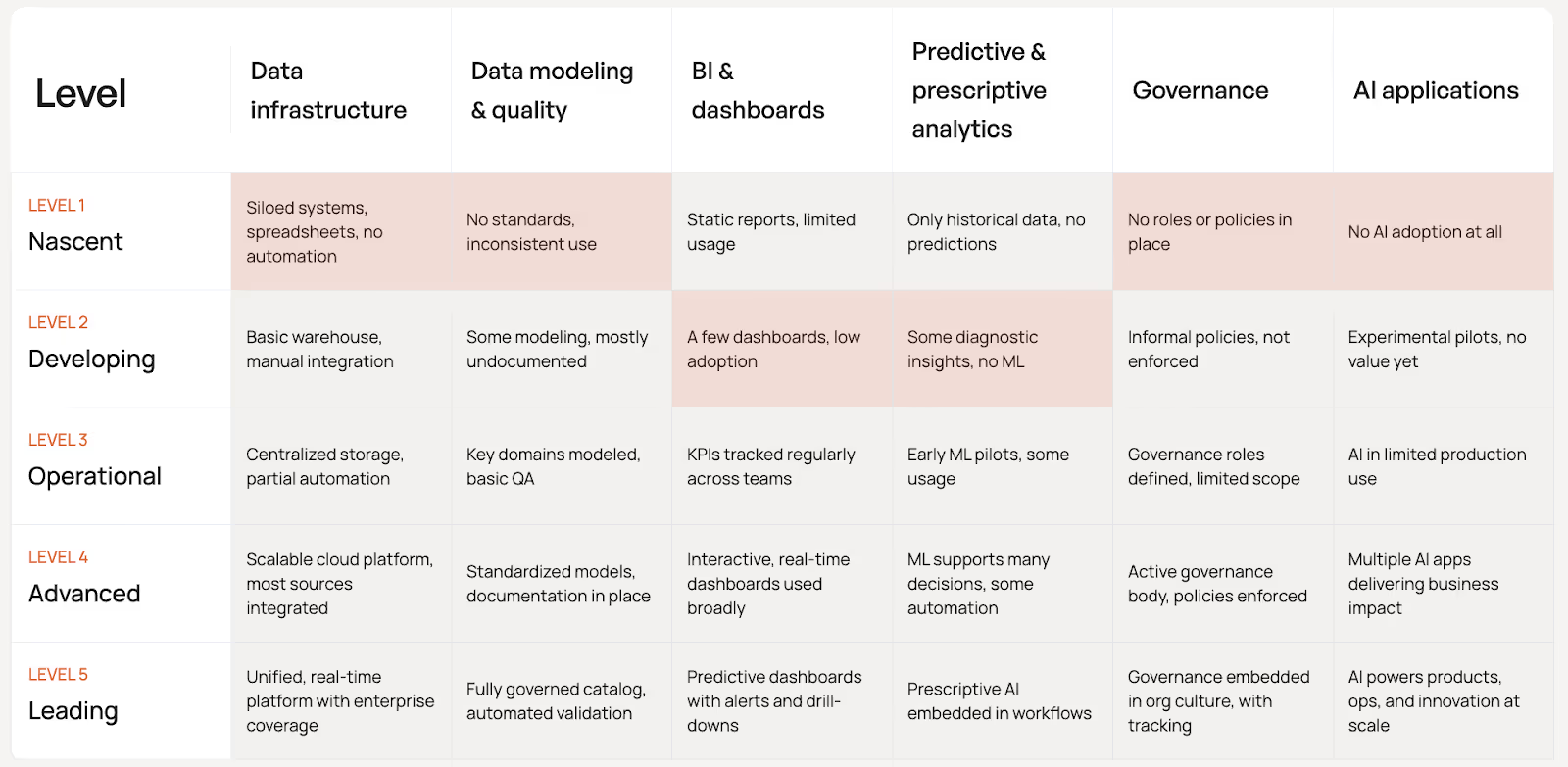Table of Contents
TL; DR
Assessing your organization’s data and AI maturity is essential, but doing it manually can be slow, subjective, and inefficient. A smarter approach is to leverage a model-driven assessment.
In just minutes, the free 5X Data & AI Maturity Assessment evaluates your company across six key dimensions and delivers a personalized maturity report with clear next steps.
Benchmark your data and AI maturity.
The challenge of gauging your data and AI maturity
If you’re like most companies, you might think you’re more data- and AI-mature than you truly are. It’s a common scenario: teams invest heavily in fancy AI initiatives, yet basic data foundations (like infrastructure or governance) remain shaky
.
Better AI isn't about more data; it is about the quality of data and its connectivity. We have assigned accountability to make sure that we just don't keep on saying the quality is bad, but keep improving it.
~ Anindita Misra, Global Director of Knowledge Activation & Trust, Decathlon Digital
How Decathlon uses data to optimize in-store operations
Problem: Without an honest maturity assessment, you risk blind spots. Maybe executives are pushing for advanced business intelligence dashboards without realizing their data quality is poor, or experimenting with predictive models while governance is a mess.
The result? Disconnected projects that never scale and teams talking past each other.
Agitate: Assessing your data and AI maturity should bring clarity but often it just brings headaches. Traditional maturity assessments can take weeks of surveys, meetings, and guesswork, only to tell you what you already sensed: that you have gaps.
Even worse, many assessments diagnose problems but don’t tell you how to fix them, leaving you with a static report and a “now what?” feeling. You need to know where you stand and how to improve, without wasting time or budget on an endless audit.
How companies manually assess maturity (and why it’s painful)

Organizations have long tried to evaluate their data/AI maturity manually. Typically, the approach varies by company size and resources:
Small business (~100 people)
Likely no formal data team. A tech-savvy manager might draft a spreadsheet checklist or use a basic survey template to score the company on data practices.
Often, it relies on whoever has some data knowledge wearing multiple hats. The result is usually an incomplete picture (e.g. “We have some reports, so I guess our BI is fine?”), because small orgs don’t have bandwidth for deep analysis.
Mid-size company (~1,000 people)
With more people and data, the assessment process becomes more organized but also more cumbersome. These companies might form a cross-functional task force to interview department heads about data usage, or even purchase a consulting workshop. They’ll gather info on infrastructure, data quality, analytics usage, etc., often through lengthy questionnaires and meetings.
It’s more formal, possibly using frameworks from Gartner or McKinsey for guidance. However, it can take several weeks or months to collect responses and compile results. By the time a mid-size firm finishes a manual assessment, the business may have evolved or the data stack changed!
Enterprise (~10,000+ people)
Large organizations often go all out; they might hire big consulting firms to perform a full data maturity audit. This involves exhaustive documentation reviews, staff surveys, stakeholder interviews, and perhaps benchmarking against industry peers. The enterprise will get a detailed report and perhaps a maturity score across various categories.
But this manual effort is slow and costly. It’s not uncommon for an enterprise assessment to span 3–6 months and hundreds of employee-hours. The outcome is a dense slide deck that, while thorough, is hard to act on. And because it’s a snapshot, it can become outdated quickly in a fast-moving enterprise environment.
No matter the size of your organization, manual assessments share some pain points:
- Time-consuming: Manual evaluations drag on for weeks or months. Teams spend countless hours in interviews and data gathering. That’s time not spent actually improving data systems.
- Subjectivity and inconsistency: The quality of a manual assessment depends on who’s doing it. Internal biases or limited perspectives can skew results. One department might overstate its capabilities while another downplays theirs. The criteria may be interpreted differently across teams, reducing precision.
- High effort, low agility: A manual process requires coordination across silos—scheduling meetings, chasing down information, consolidating spreadsheets. It’s a heavy lift. And if something changes (a new tool implemented, a process improvement), you can’t easily update the assessment without another round of work.
Unfortunately, that’s why Excel is still so popular and successful; people don’t have the tools in place to trust the data they have inside the organization.
~ Christopher Pile, Managing Partner, MISSION+
Webinar: How to get your data ready for AI
- Generic outputs: Traditional assessments often yield a static report with a maturity rating and generic recommendations. They identify gaps but don’t tailor next steps to your context. You get a sense of “we’re Level 2 in governance” but little guidance on immediate actions specific to your business.
- The “so what” problem: Perhaps the biggest issue is, after all that work, you have a nice report. But then what? Many manual assessments diagnose but don’t deliver results. There’s no quick path to execution. You’re left knowing your weaknesses, but having to figure out how to address them (often via separate projects or more consultants).
In short, manual assessments can tell you there’s a problem, but they rarely help you solve it efficiently. It’s like getting a medical check-up that says “you need to exercise” and then being left on your own to figure out the workout plan.
There’s a better way…
Manual vs. model: which is the smarter path?
Let’s compare doing it the old way (manual) versus using a modern model-driven approach.
Inside the 5X Data & AI Maturity Model: five tiers across six dimensions
So what exactly does the 5X Data & AI Maturity Assessment measure? The model evaluates your organization across six critical dimensions of data and AI capabilities:

- Data infrastructure: How you store, integrate, and manage data (from siloed spreadsheets to modern cloud data platforms).
- Data modeling & quality: How you structure your data and ensure its accuracy/consistency (standards, documentation, data cleaning, validation processes).
- Business intelligence & dashboards: How you turn data into insights for end users (ad-hoc reports vs. self-service dashboards, real-time analytics, adoption across the org).
- Predictive & prescriptive analytics: How you use advanced analytics and machine learning (from purely historical analysis to forecasting, AI-driven decision support, and automation).
- Governance: How you handle data governance, security, and privacy (informal or missing policies vs. formal governance roles, policies enforced, data cataloging and tracking).
- AI applications: How extensively AI is embedded in products and operations (experiments and pilots only, versus AI powering core business processes at scale).
Each of these six pillars is assessed via targeted questions. Based on your answers, the model determines your maturity level in each dimension and overall. The outcome is a placement into one of five maturity tiers (levels) that 5X defines, aligned with common industry models:

- Tier 1 – Nascent: Early-stage and ad-hoc. Data is scattered and processes are mostly manual. For example, systems are disconnected and reliant on spreadsheets; there’s no automation to speak of. Analytics is minimal and reactive. Essentially, you’re at the beginning of the data journey.
- Tier 2 – Developing: Basic capabilities in place. Perhaps you have a simple data warehouse and a few dashboards, but integration is manual or limited. Some data models exist but are not well documented. There might be experimental AI pilots, but no real value delivered yet.
- Tier 3 – Operational: Intermediate maturity. You’ve centralized a lot of data and achieved partial automation in pipelines. Key domains have standardized data models and quality checks. Teams regularly use dashboards for KPIs, and you’ve run early ML pilots that see limited use. Governance has started (roles defined), and maybe one or two AI use cases are in production.
- Tier 4 – Advanced: High maturity. A scalable, cloud-based data platform underpins your operations, with most data sources integrated automatically. Data modeling is standardized enterprise-wide with good documentation. Dashboards are interactive, real-time, and broadly adopted across departments. Machine learning informs many decisions, and some processes are even automated by predictive or prescriptive models. A governance board actively enforces policies. Multiple AI applications are delivering real business impact at this stage.
- Tier 5 – Leading: Cutting-edge maturity. You are among the best: unified, real-time data platform covering the entire enterprise, with fully automated data quality and governance embedded in the culture. Analytics is not just predictive but prescriptive: AI/ML is embedded in workflows and products, driving innovation. Data is a strategic asset used at scale, and AI powers products, operations, and decision-making across the board. In short, you’re data-driven at the core, setting the benchmark for others.
When you take the assessment, your responses are mapped to these tiers. You might discover, for example, that you’re Tier 2 overall (Developing), not as far along as you thought, with perhaps a Tier 3 in infrastructure but only Tier 1 in governance. This nuanced view is incredibly helpful: it highlights which areas are holding you back the most.
From assessment to action: a faster path to data excellence
Success, first and foremost, doesn’t mean perfect data. Nobody has perfect data. But it means that you are confident in your action… if the model gives you insights that you trust… then I think you’re ready to go into production.
~ Gaia Camillieri, Managing Director, MISSION+
Webinar: How to get your data ready for AI
Performing a manual maturity assessment might feel like homework, but using the 5X model feels like a strategy session with an expert compressed into minutes. Instead of laboring over questionnaires and waiting on reports, you’ll answer a concise set of questions and get immediate clarity.
Imagine being able to confidently tell your team, by the end of the day, “Here’s where we stand on data and AI, and here’s what we need to do next.”
It’s also a way to build alignment. When you share the assessment results, different stakeholders suddenly speak the same language. The report provides a common framework:
- CEO finally understands why data platform investments are needed
- business units see the value of improving data quality before chasing the next AI shiny object
- the abstract concept of “maturity” becomes concrete. (No more vague promises of “we should be more data-driven.”)
-
All of this happens far faster than any traditional approach. What manual assessment might uncover (with effort) in a quarter, you can learn with 5X over a coffee break.
So, skip the spreadsheets and consulting calls. Try the model-driven way.
The 5X Data & AI Maturity Assessment is free, quick, and eye-opening. It’s the smart shortcut to understanding your data capabilities.
Take the assessment, get your personalized maturity report, and use it as a springboard for your data strategy.
FAQs
How do you assess AI maturity?

How to assess data maturity?

How to ensure your data is AI-ready?

How to assess data maturity level?

Building a data platform doesn’t have to be hectic. Spending over four months and 20% dev time just to set up your data platform is ridiculous. Make 5X your data partner with faster setups, lower upfront costs, and 0% dev time. Let your data engineering team focus on actioning insights, not building infrastructure ;)
Book a free consultationHere are some next steps you can take:
- Want to see it in action? Request a free demo.
- Want more guidance on using Preset via 5X? Explore our Help Docs.
- Ready to consolidate your data pipeline? Chat with us now.

How retail leaders unlock hidden profits and 10% margins
Retailers are sitting on untapped profit opportunities—through pricing, inventory, and procurement. Find out how to uncover these hidden gains in our free webinar.
Save your spot









%201.svg)

.png)
.png)






